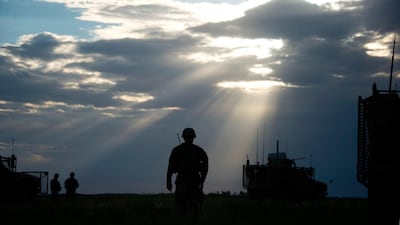President Donald Trump said on Thursday the US plans to withdraw more than 5,000 troops from Afghanistan before it determines further drawdowns to end the longest war in American history.
Mr Trump’s comment comes as a US envoy is in his ninth round of talks with the Taliban to find a resolution to the near 18-year-old conflict. The president said the US was “getting close” to making a deal, but the outcome remains uncertain.
"Who knows if it's going to happen," Mr Trump told Fox News Radio, not offering a timeline for troop withdrawal.
Although the Pentagon has been planning to withdraw as many as half of the 14,000 US troops still there, the Taliban wants all US and Nato forces taken out. Nato has a mission in Afghanistan with 17,000 soldiers from several countries.
“We’re going down to 8,600 (troops) and then we’ll make a determination from there,” Mr Trump said, adding that the US is going to have a “high intelligence” presence in Afghanistan going forward.
Reducing the number of troops to 8,600 would bring the total down to about where it was when Mr Trump took office in January 2017.
The US had 9,000 troops in Afghanistan in 2016, during the Obama administration, and 8,000 in 2017, according to the Nato/Resolute Support mission.
The US president has called Afghanistan — where the Taliban harbored members of the al-Qaida network responsible for 9/11 — the “Harvard University of terror.”
Al-Qaida insurgents used Afghanistan as a base from which to plan the September 11, 2001, attack on America. A month later, US troops invaded Afghanistan, where they have remained ever since. More than 2,400 American service members have died in the conflict.
A Taliban spokesman also has said that they’re close to a final agreement, despite there being constant attacks by the Taliban across Afghanistan, and an affiliate of ISIS is expanding in the country.
“Taliban and ISIS are still potential threats for the national security of Afghanistan and the US. The Afghan government strongly believes that any reduction of US forces in Afghanistan will be based on conditions on the ground,” Sediq Seddiqi, a spokesman for Afghan President Ashraf Ghani, said in a statement.
Afghanistan’s government expects that US envoy Zalmay Khalilzad will soon update officials in Kabul on the progress of peace talks with the Taliban.
Mr Khalilzad met with Afghan President Ashraf Ghani on Wednesday night to discuss the next steps.
But even if the envoy is able to close a deal, it will remain for the Afghan government to negotiate its own peace agreement with the Taliban. Part of those talks will be determining a role for the Taliban in governing a country that it ruled before US forces invaded in October 2001.
There are also concerns in Kabul that a hasty US withdrawal will lead to the Taliban gaining the upper hand in the war despite assurances from Mr Khalilzad that America will not abandon the government.

